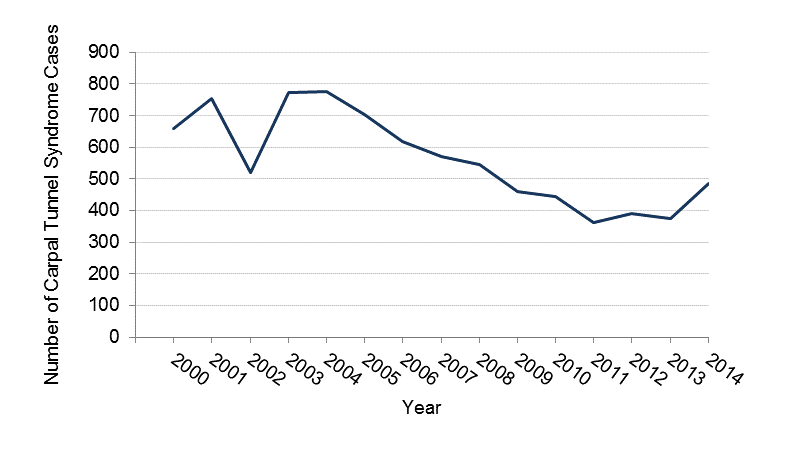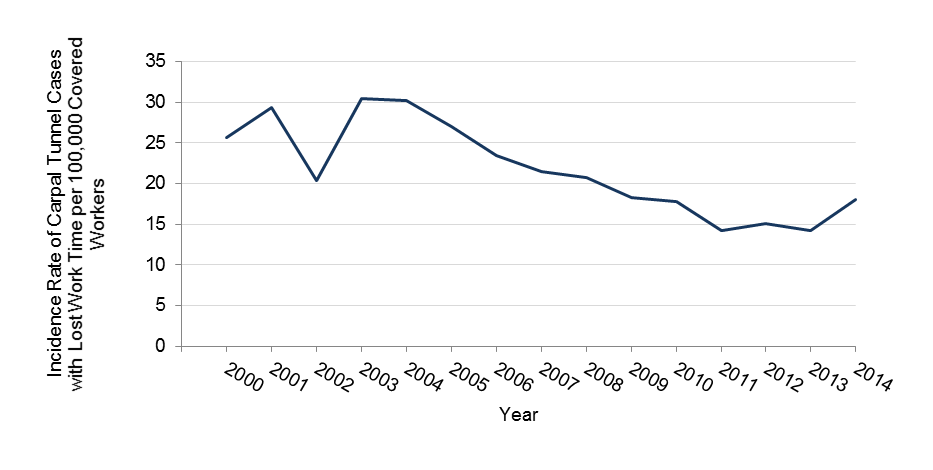Carpal Tunnel Syndrome with Lost Work Time Involving Workers Compensation Claims
This indicator identifies the number of Minnesota employees who have filed a workers’ compensation claim with indemnity due to work-related carpal tunnel syndrome.
Carpal tunnel syndrome occurs when the median nerve, which runs through the forearm into the hand, becomes compressed or squeezed while passing through the wrist. Carpal tunnel may occur from repetitive motion or action, injury or trauma, or overexertion of the wrist in daily operations. With appropriate workplace controls and an ergonomic configuration of a workstation, carpal tunnel syndrome is preventable.
This indicator is based on claims data from the Minnesota’s workers' compensation system. The data is compiled and supplied by the Minnesota Department of Labor and Industry. In Minnesota, a work-related injury or illness must be reported if that injury or illness incapacitates the employee for more than 3 days or if it requires medical attention. These time and severity requirements could result in under-reporting. Also, specific occupations are excluded from the reporting requirement including farmers, independent contractors, federal employees, railroad and longshore and maritime workers. Finally, as carpal tunnel syndrome may develop gradually over extended periods of time, workers, employers, and health care providers may be unaware of the work-related nature of the injury/illness and fail to report or make a claim. These factors together contribute to the under-reporting of carpal tunnel syndrome and underestimation by this indicator of the number of Minnesota employees affected by carpal tunnel syndrome.
Number of Carpal-Tunnel Syndrome cases with Lost Work-Time Filed with Minnesota Workers’ Compensation, 2000-2014
| Year | Number | Rate per 100,000 Workers Covered by Workers’ Compensation |
| 2000 | 658 | 25.6 |
| 2001 | 755 | 29.3 |
| 2002 | 519 | 20.3 |
| 2003 | 774 | 30.5 |
| 2004 | 776 | 30.2 |
| 2005 | 705 | 27.0 |
| 2006 | 619 | 23.5 |
| 2007 | 570 | 21.5 |
| 2008 | 545 | 20.7 |
| 2009 | 460 | 18.3 |
| 2010 | 445 | 17.8 |
| 2011 | 362 | 14.2 |
| 2012 | 392 | 15.1 |
| 2013 | 376 | 14.2 |
| 2014 | 485 | 18.1 |
Number of Carpal-Tunnel Syndrome Cases with Lost Work-Time Filed with Minnesota Workers’ Compensation, 2000-2014

Rate of Carpal Tunnel Syndrome Cases with Lost Work-Time Filed with Workers’ Compensation per 100,000 Workers Covered by the Minnesota Workers’ Compensation System, 2000-2014

The number of carpal tunnel cases with lost work-time that are reported to the Workers’ Compensation system have declined over the past fifteen years. Ttrend analysis indicates that the decline was statistically significant.
For resources on ergonomics and how to prevent musculoskeletal disorders, as well as research regarding musculoskeletal disorders, please visit the National Institute for Occupational Safety and Health’s website http://www.cdc.gov/niosh/topics/ergonomics/.